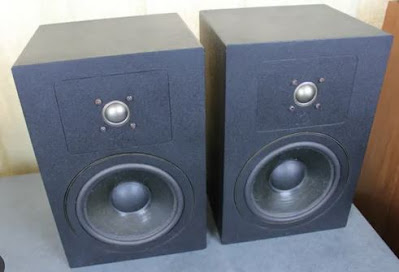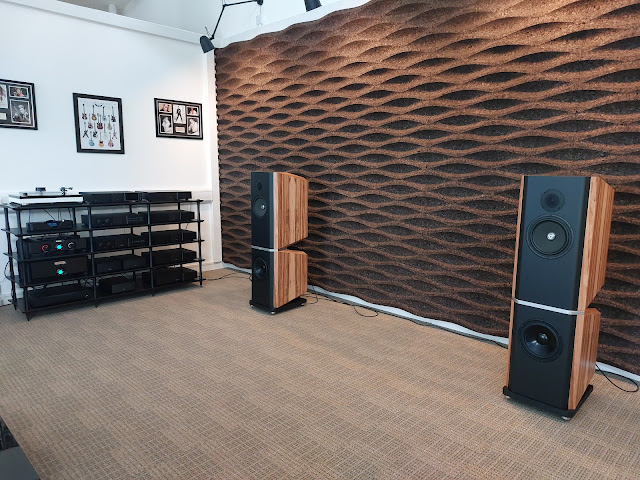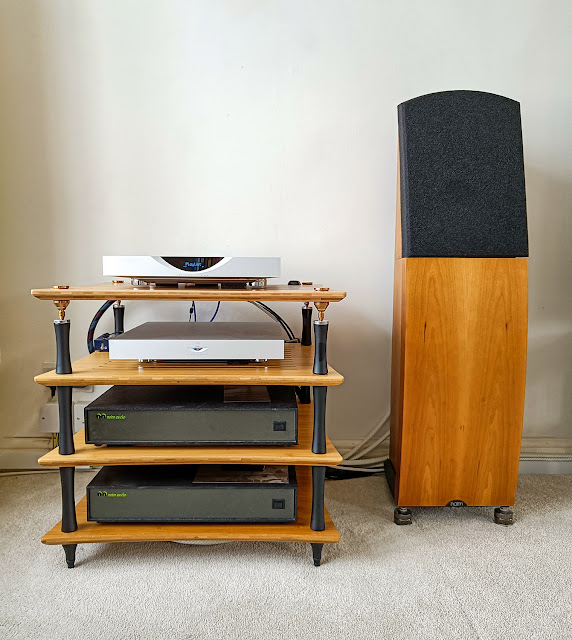Now a very visible and significant player on the international high quality audio scene, Kudos Audio has taken a different approach to producing music for its enthusiastic customers and are actively pursuing new ideas, as I type.
Favourable reviews are now the norm for the company's Titan range, including a number on Audiophile Musings. Step this way to get a flavour of what the reviewers are saying about the company's products and some of the numerous awards and accolades bestowed upon them:
Audiophile Musings "Sound of the Show" at Bristol 2020 with Titan 707
Audiophile Musings went to find out what makes the company tick, being invited for an exclusive factory tour in the North East of England, UK - it turned into a 5 hour history lesson, factory tour, Titan 808 listening session, and zero nonsense...
Most of you will be familiar with the old joke:
Tourist: "how do I get to Town X"
Local: "well, I wouldn't start from here if I was you..."
I came away with the impression that the Kudos story has a similar origin. Derek Gilligan, founder and head honcho at Kudos has a solid background to work from with a family in the music and live music PA business, but the route from there to today took an interesting path. Today's Kudos is a testimony to thinking differently, building a team that incudes family & those you can trust, being obsessive about quality and ensuring the basics are right.
As a fellow Darlingtonian, it was easy to chat with Derek about the pros and cons of "Darlo" and the area in which we grew up. Different schools though, so not totally parallel experiences. I very much remember my early forays into hifi in the 1980s and they were supported by some canny purchases from used audio specialists in High Northgate, Darlington "North East Audio Traders". Derek became part of the team there and may even have served me in the shop, but thankfully neither of us remember! North East Audio Traders was a novel idea in the region at the time and was reasonably successful. Going to hifi shows to demonstrate their equipment was part of the game, but speaker consistency proved a challenge. Hence the guys at N.E.A.T. put together a small standmount of their own to enable easy comparison between equipment that's just not possible when a stock of used speakers is constantly changing from day to day. Soon reviewers were asking to review the speaker in its very rudimentary form, but were very complementary about the way it performed. Derek was involved in the speaker using a renowed driver from earlier speaker products that needed to be sourced from wherever they were still available from stock. Eventually this driver had to be re-manufactured once the speaker took off in the market. It was partnered with a modern dome tweeter. The NEAT Petite is now a very well known speaker and continues in a revised form to this day, as the Petite Classic.
 | |||
| Original NEAT Petite Loudspeakers |
The design process of Petite, based on listening for musicality and a try and re-try approach set the tone for the future. What Hifi? were impressed with the result "as tuneful as they come". When demonstrating the speakers, N.E.A.T. used the exceptionally substantial Kudos speaker stands...
Derek parted ways with NEAT for a few years, pursuing other activities until he returned for a second stint with the company to work on speaker designs such as the Ultimatum, where we can see techniques such as isobaric bass loading being deployed, as it is in today's Titan range (also used elsewhere such as Linn's Akubarik). NEAT bought the Kudos brand as part of buying up the stock of speaker stands as Kudos' then owner moved on to different products and markets. During this time Derek had developed some design ideas he wanted to try but the opportunity wasn't presented to go in that direction. Time for a new direction...
So we come to the inception of Kudos Audio as a speaker manufacturer in its own right - a "do or die", "all or nothing" decision for Derek and his wife. With a good network of contacts in the industry and dealerships, understanding what was wanted in the market and what was possible from a design perspective, the initial Cardea products, although fairly conventional in construction, were very well received and the business was underway. The basic tenets behind those early designs hold true today - listen, listen, listen, use high quality components, gentle slope crossovers to minimise component count and phase distortion, build in the UK using UK producers and components wherever possible. But the scale has moved on, as has the size and breadth of the product range.
Based in the North East of England (close to Derek's roots) isn't the UK hifi heartland, but everything is within easy reach and, of course, electronic communications mean distance isn't the blocker it used to be. The company is split across 3 sites on the same compact business park - storage, manufacturing and design / demo buildings. This is the second location for the company and it has grown into the current arrangements organically - annexing a next door unit here, installing a mezzanine floor there, plus the major investment in the design / listening / demo suite. Its a compact, cleanly presented, logically laid out facility. This appears to work very well for the core workforce, consisting of Derek, production manager Mark with Derek's son Louis looking after quality control and his daughter Kay joining the team on the week of my visit to take on office management, accounting etc. after several years experience in similar roles in other companies. The extended team includes another 7 colleagues across sales, marketing and export colleagues based locally or where the dealer network needs them to be.
We talked through the design and manufacture of the higher, and very successful, Titan range of products to understand the Kudos approach. Essentially Derek uses the experience of existing designs and applies new ideas to those products or completely new concepts to push the boundaries of what's possible and what's effective - sometimes it shows promise, sometimes it doesn't, sometimes it takes very little refinement to be just what he's hoping for. The exact percentage of those outcomes wasn't shared with me :) An example is using isobaric loading for the mid-bass drivers in Titan 505, 606 and 707. Basically isobaric means 2x drivers - one internal, the other on the front baffle - linked by a sealed air chamber between those drivers, giving the impression of a much larger single drive unit in a larger cabinet. Its unusual in the industry to use isobaric so high in the frequency range, but Kudos found that allowing a minimal air gap around the voicecoil of the driver, coupled with "back to back" driver mounting reduced the effect of differences between drive units (even very expensive drive units are never identical) to give a better performance over a wider frequency range.
Another example of experienced based innovation is the cabinet construction of Titan. Its core is a relatively thin MDF structure, the panels of which flex (the deflection is not visible to the eye) because the outer panels of the cabinet, in heavier gauge veneered MDF, are compliantly coupled to damp the flex of the inner cabinet wall. A mix of 2 existing, usually mutually exclusive, philosophies in the industry, but applied in a different way. The composition of the damping disks connecting inner cabinet to outer cabinet and the exact location of the mounting points were subject to the iterative try, listen, change, listen, change, listen approach until the best sounding materials and mounting locations were established. A further example of the design approach is that each panel in the internal cabinet has one of a number of thickness options - to vary the natural resonance of each panel rather than having all the panels contributing one resonance.
 |
| Titan 606 Inner Cabinets and Connector / Crossover Panels |
Kudos work very closely with Norwegian driver manufacturer SEAS who have been found to be exceptionally co-operative and collaborative on driver design changes - be that cone materials, coil winding, cone shape, doping etc. etc. Only the basic driver basket remains unchanged for mid-bass drivers, everything else is available to change and Kudos exploits that opportunity with drivers going through several iterations before being custom manufactured to their final spec. The Krescendo tweeter used in Titan is another example of the collaboration with SEAS, being based on a existing metal dome driver but with the magnet from a different SEAS model and the dome using a fabric and shape of Kudos' choice. As a component, compared to those in many other loudspeakers, the Titan tweeter is "reassuringly expensive".
 |
| SEAS Mid-Bass Drivers to Kudos Custom Spec |
We step through the build process. Cabinets are, of course, Kudos designs, but built by specialist suppliers. A subject of intense discussion in the UK speaker manufacturing industry right now as one of the major suppliers of cabinets to the vast majority of UK loudspeaker brands has abruptly ceased supply. For a small company this means a great deal of disruption to source a new supplier, but this looks to be resolved for Kudos and supply will continue to be delivered to customers as there are good stocks of parts in place right now. Every cabinet (internal and external damping panels, stand components etc) are inspected for any imperfections before being accepted and placed into stock. With Titan the internal cabinet remains consistent and the external damping panels bring the differences in colours and veneers. A number of veneers are available as are piano black and white gloss.
Drive units come in from SEAS in batches, passive crossovers are constructed on the production benches. Crossovers for Titan are hand built on the connector panel with components being direct wired (no circuit board) and use very gentle crossover slopes and the natural roll-offs of the drivers in the cabinets as Kudos believe this reduces "stuff getting in the way of the music". Its a relatively expensive way of making crossovers, but demonstrates the passion for getting the right end result. All the components for a complete speaker pair - drivers, internal cabinet, external damping panels, crossover, stands, packaging, connector panels, etc, - are gathered together onto a single pallet. This pallet is then transferred to the build area for assembly by one member of the team. Seeing the details of the drivers, and the layered construction of what look like relatively simple stands opens my eyes to how much effort has gone into the design of Titans, something not at all obvious to the customer. Every pair is then put through listening tests before being packaged ready for despatch.
Alongside the build area is a newly constructed office unit and the basics needed to keep the team fed and watered through the day.
 |
| Titan 808 Crossovers - Bass on the Left, Mid and Treble on the Right |
We move over to the design / listening / demo suite where, in typical Kudos fashion, we enjoy a straightforward sandwich and cuppa whilst listening to the system currently set up. At this point we also discuss the "active" option for Super 10A, Super 20A and the Titan range, and why Kudos chose to go in that direction, another distinctive differentiator in the market. It is, unsurprisingly, a fairly simple answer - to get a better musical result. As an independent manufacturer, with no ties to existing electronics partners, Kudos can work with multiple different active electronics partners with ease. Linn, Naim, Exposure and Devialet options have been made available and the speakers can be converted to active operation with a simple change to links on the connection panel.
 |
| Listening Room with Titan 808 |
Kudos have long been a favoured brand of speaker amongst Naim electronics customers and that manufacturer's kit has featured extensively during the development of Kudos products and demonstrations at hifi shows (in passive and active form), along with Linn's Exakt active option. But today we have a system fronted by an Innuos server / streamer, Chord DAVE DAC, Chord Ultima Pre and Ultima Power amps. This was a surprise choice for me, given my past experience with Chord amplification hasn't been so enjoyable. But this new Ultima range changes that completely, being musical, with coherent timing. This system was feeding Titan 808s passively through, of course, Kudos KS-1 speaker cables. We range through some church choral recordings (great representation of the space), electronic dance music (great pace, controlled impactful bass lines) and Leonard Cohen (expressive grumbling vocals) and the time passes very quickly enjoying the music (note, the music, not the treble nor bass nor mids!).
What of the future? Well Kudos have lots more ideas to take through their iterative, listening based process of product innovation and improvement. Some interesting ideas on drive units and active options could be on the way if they meet that essential criteria - is it musically more enjoyable than what went before? If today's products are anything to go by, the results will be interesting indeed.
Thanks very much to Derek and the Kudos team for your time, openess, straightforward discussion and hospitality.



